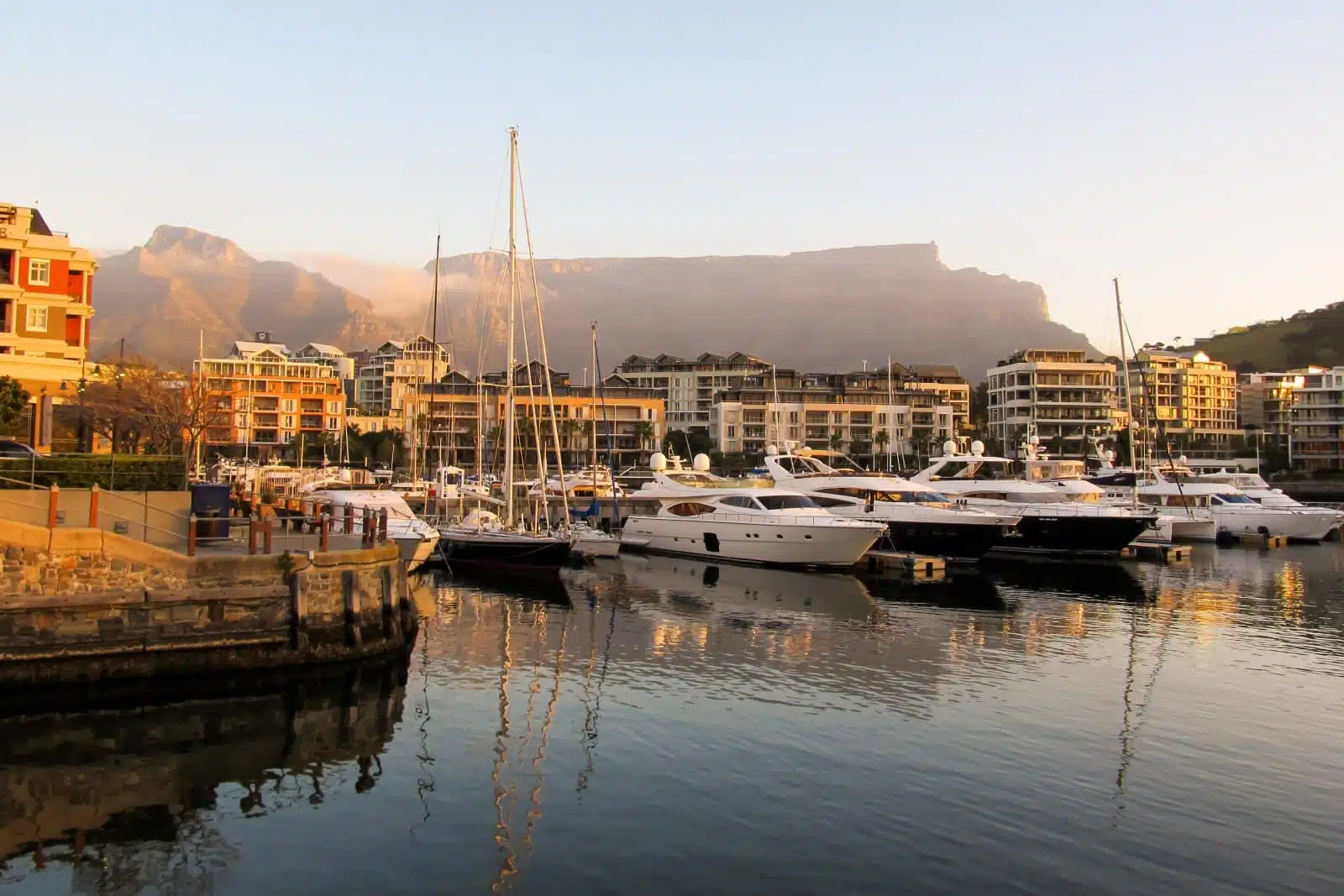Exploring South Africa has always been a dream. From vibrant colors to majestic wildlife, Cape Town is a gem blending natural beauty and culture. My guide crafted a perfect day: hike Table Mountain, wander Bo-Kaap, lunch at V&A Waterfront, visit Kirstenbosch, and end with a Camps Bay sunset. Each spot reveals Cape Town’s diverse charm.
Morning Hike Up Table Mountain

Image Credit: Pexels / Taryn Elliott
Table Mountain, a majestic landmark that dominates Cape Town’s skyline, offers more than just a backdrop to the city; it provides an immersive nature experience. The hike up Table Mountain is challenging and rewarding, with several routes varying in difficulty. The Platteklip Gorge route is the most direct, while the India Venster offers more dramatic views. Reaching the summit reveals panoramic vistas of the city, the Atlantic seaboard, and the surrounding mountains, making the exertion worthwhile. The Table Mountain Aerial Cableway is an alternative for those who wish to enjoy the views without the hike.
My Insider’s Tip: Start early to avoid the midday heat and crowds, especially during summer. Ensure you have water, sunscreen, and a hat, as the sun can be intense even in cooler temperatures.
Visit the Bo-Kaap Neighborhood

Image Credit: Shutterstock / LongJon
Bo-Kaap, known for its brightly colored houses and cobbled streets, is a historic area that tells the story of Cape Town’s multicultural heritage. This neighborhood, formerly known as the Malay Quarter, is significant for its Cape Malay culture, a community descended from enslaved Southeast Asians brought by Dutch colonists. Walking through Bo-Kaap offers a feast for the eyes with its vivid architecture and exploration of the city’s rich history and culture, with museums, mosques, and authentic Cape Malay cuisine available for exploration.
My Insider’s Tip: Visit the Bo-Kaap Museum to gain insights into the life of a typical Malay family in the 19th century and try traditional Cape Malay dishes like bobotie or koeksisters at local eateries.
Lunch at the V&A Waterfront

Image Credit: Shutterstock / Marieke Peche
The Victoria & Alfred Waterfront is a vibrant center of activity, seamlessly merging shopping, dining, and entertainment against the spectacular backdrop of Table Mountain and harbor views. This locale offers an ideal setting for a relaxed lunch, with a diverse mix of dining options from cozy cafes to upscale restaurants, alongside many shopping opportunities ranging from unique local crafts to renowned international brands. The waterfront is a modern commercial hub and a site rich in history, home to numerous heritage sites and museums that narrate South Africa’s maritime history. Among the culinary highlights is Baía Seafood Restaurant, a premier seafood spot at the Waterfront renowned for its scenic harbor and Table Mountain views. Baía has garnered acclaim for its selection of fresh, high-quality seafood, presenting a menu that spans a variety of seafood dishes such as steamed black mussels in Riesling and perfectly grilled calamari tubes, as well as offering prime steaks and poultry for a broader dining experience.
My Insider’s Tip: Don’t miss the opportunity to visit the Zeitz Museum of Contemporary Art Africa (MOCAA), housed in a converted grain silo.
Afternoon at Kirstenbosch Botanical Gardens

Image Credit: Shutterstock / Finn stock
Nestled at the eastern foot of Table Mountain, Kirstenbosch National Botanical Garden is renowned for its stunning display of South Africa’s diverse flora. This UNESCO World Heritage Site is a haven for plant lovers and those seeking tranquility alike, offering meticulously curated gardens, walking trails, and the iconic Boomslang canopy walkway that snakes through the treetops. Kirstenbosch is not only a place to appreciate the beauty of nature but also a venue for art, with sculptures dotting the landscape, and for music, hosting summer sunset concerts that blend culture with natural beauty.
My Insider’s Tip: Pack a picnic to enjoy in one of the garden’s many serene spots, and don’t miss the opportunity to walk the Boomslang canopy walkway for a unique perspective on the gardens.
Sunset at Camps Bay Beach

Image Credit: Shutterstock / RomanSlavik.com
Camps Bay Beach’s pristine white sands and crystal-clear waters epitomizes Cape Town’s beach culture. Framed by the Twelve Apostles mountain range and the Atlantic Ocean, it’s an idyllic spot to unwind and watch the sun dip below the horizon. A lively promenade, home to chic cafes, bars, and restaurants perfect for an evening cocktail or dinner flank the beach. The natural beauty, cosmopolitan atmosphere, and spectacular sunsets make Camps Bay an essential Cape Town experience.
My Insider’s Tip: Secure a spot on the beach early to find the best position for sunset views. After the sun sets, choose a restaurant along the promenade for dinner to end your day with the sound of the waves in the background.
A Potted History of Cape Town

Image Credit: Shutterstock / Andrea Willmore
Cape Town, known affectionately as the Mother City, holds a pivotal place in South Africa’s history, blending cultural diversity with historical significance. Founded in 1652 by the Dutch East India Company as a supply station for Dutch ships sailing to East Africa, India, and the Far East, Cape Town is the oldest urban area in South Africa and has played a crucial role in global maritime trade.
The initial purpose of the settlement was to provide fresh food and water to the company’s fleet on the long journey between Europe and Asia. Jan van Riebeeck, the first commander of the Cape, established a victualling station where ships could restock on essentials, which marked the beginning of permanent European settlement in Sub-Saharan Africa. This led to the development of a refreshment station that soon grew beyond its initial purpose, attracting settlers and traders.
The introduction of slavery in 1658 became a dark chapter in the city’s history, with slaves being brought from Indonesia, Madagascar, and parts of Africa to work in the Cape. The blend of cultures, languages, and religions led to the unique Cape Malay culture, which continues to influence the city’s cultural and culinary landscape.
The British took control of Cape Town in 1795 during the Napoleonic Wars, a move initially intended to prevent the French from using the Cape Sea Route. The British occupation brought about significant changes, including the abolition of slavery in 1834, which had profound social and economic impacts. The discovery of diamonds and gold in the interior in the late 19th century transformed the city into a major economic hub and a gateway to the African continent.
The 20th century saw Cape Town grappling with the harsh realities of apartheid, a policy of racial segregation that left deep scars on the city and its inhabitants. District Six, an area in Cape Town, became emblematic of the apartheid regime’s brutality when, in 1966, it was declared a white-only area, leading to the forced removal of over 60,000 residents and the destruction of their homes.
Cape Town played a significant role in the anti-apartheid movement, with Robben Island, located off its coast, serving as a prison for political activists, including Nelson Mandela, who spent 18 of his 27 years in prison there. The fall of apartheid in 1994 marked a new beginning for Cape Town, ushering in an era of democracy, reconstruction, and development.
Today, Cape Town is celebrated for its breathtaking natural beauty, rich cultural heritage, and vibrant urban life. The city’s history, from its origins as a refreshment station to its pivotal role in South Africa’s story, continues to shape its identity and resilience. Cape Town stands as a testament to the complexities of human history, showcasing the capacity for transformation and renewal amidst challenges.
The People of Cape Town

Image Credit: Shutterstock / Omri Eliyahu
The People of Cape Town, a diverse and vibrant population, reflect the city’s complex history and cultural amalgamation. Known as Capetonians, Cape Town’s inhabitants come from various ethnic backgrounds, including but not limited to African, Coloured, Indian, and European descent, each contributing to the city’s rich cultural history.
Historically, the city’s demographic landscape was shaped by significant events, such as the arrival of Dutch and British colonizers, the importation of slaves from Southeast Asia and Africa, and the migration of Indian laborers. This blend of cultures has influenced the social fabric, languages, culinary tastes, and religious practices in Cape Town, making it a unique melting pot of global cultures.
Capetonians are known for their warm hospitality and laid-back lifestyle, which is deeply intertwined with the city’s natural beauty. Outdoor activities, such as hiking, surfing, and wine tasting, are popular among locals, reflecting a deep appreciation for the city’s geographical splendor.
Despite the scenic beauty and cultural wealth, Cape Town faces challenges, including socio-economic disparities and a legacy of apartheid that still affects its urban and social structures. Efforts to address these issues are ongoing, with community initiatives and governmental policies aimed at promoting inclusivity and improving the quality of life for all residents.
When to Travel

Image Credit: Pexels / Leeloo The First
The optimal time to visit Cape Town largely depends on the visitor’s interests. The city enjoys a Mediterranean climate with mild, wet winters and warm, dry summers. For beachgoers and those interested in outdoor activities, the summer months from December to February offer sunny days with temperatures averaging between 20°C to 28°C (68°F to 82°F). However, this period also coincides with the peak tourist season, when the city experiences its highest influx of visitors.
For travelers looking to explore the city’s cultural sites and enjoy its natural beauty with fewer crowds, the shoulder seasons of spring (September to November) and autumn (March to May) are ideal. These months offer mild weather, perfect for hiking, visiting vineyards, and exploring outdoor markets. The spring season, in particular, showcases the region’s spectacular floral bloom, especially at the Kirstenbosch Botanical Gardens.
How to Get There

Image Credit: Shutterstock / izfoto
Cape Town is accessible by air, land, and sea, with Cape Town International Airport serving as the primary entry point for international and domestic flights. The airport is well-connected globally, offering direct flights from major cities in Europe, Asia, and other African countries, as well as frequent domestic flights from within South Africa.
For those traveling within South Africa, long-distance buses and trains offer services to Cape Town from major cities like Johannesburg and Durban. The journey provides an opportunity to witness South Africa’s diverse landscapes, though travel times can be long.
Driving to Cape Town offers a scenic route, especially along the Garden Route from Port Elizabeth or the coastal road from the Eastern Cape. Car rentals are available at major airports and city centers, providing flexibility for visitors to explore the city and its surrounding areas at their own pace.
For maritime enthusiasts, Cape Town’s port welcomes a number of international cruise ships, particularly during the summer months, offering an alternative and scenic arrival experience.
The Bottom Line

Image Credit: Shutterstock / PeopleImages.com – Yuri A
Your day in Cape Town is a journey through the heart of South Africa’s Mother City, from the heights of Table Mountain to the historic streets of Bo-Kaap, the bustling V&A Waterfront, the tranquil Kirstenbosch Botanical Gardens, and the picturesque sunset at Camps Bay Beach. Each destination offers a unique perspective on Cape Town, combining to create a rich tapestry of experiences. As you explore, remember that the essence of Cape Town lies not just in its landmarks, but in the spirit of diversity, nature, and history that defines it. Embrace each moment, for in Cape Town, every sight, sound, and taste tells a story of its own.
More From The Green Voyage
12 Best Practices for Sustainable Travel in 2024 – How to Travel With Minimal Environmental Impact
Unlocking Hotel Perks – A Traveler’s Guide to Maximizing Hotel Reward Programs for Optimal Benefits
Travel Hacks for Frequent Flyers – 6 Tips and Tricks to Make the Best of Air Travel
The post One Day in…Cape Town, South Africa first appeared on The Green Voyage.
Featured Image Credit: Shutterstock / fokke baarssen.
For transparency, this content was partly developed with AI assistance and carefully curated by an experienced editor to be informative and ensure accuracy.
